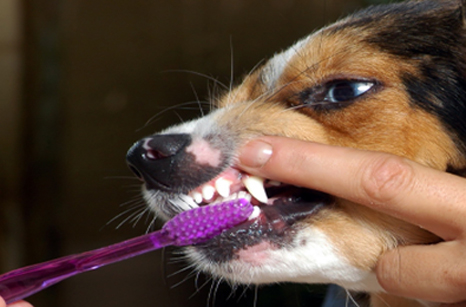Like us, every time our pets eat there is a bacterial film called plaque, which builds up on the surfaces of their teeth. When mixed with calcium this forms hard deposits on the teeth called tartar. Over time, plaque and tartar on the teeth contribute to gum recession around the base of the tooth. Infection soon follows and the gums recede further. If the disease is caught at an early stage and a thorough veterinary dental scaling and polishing is performed, most of the teeth and gums will have a full recovery. However, if left untreated, irreversible periodontal disease will occur. Untreated infection then spreads into the tooth socket and ultimately the tooth loosens and is lost. As the oral infection increases tonsillitis and pharyngitis can also occur. In addition, the bacteria are absorbed into the blood stream and can be carried to other organs.
Unfortunately periodontal disease is very common and over 2/3 of dogs and cats over the age of 3 years have some form of dental disease.
Teeth Brushing is the best way to prevent plaque and tartar accumulation. However, like their human counterparts, even with regular brushing, your pet will need their teeth professionally cleaned from time to time. The frequency of the cleanings will depend on your home dental care routine and on how much plaque your pet produces and how susceptible they are to periodontal disease.
Small breed dogs such as Poodles, Yorkies and Shih Tzu’s are particularly susceptible to periodontal disease so regular home brushing and oral exams are particularly important.
During a dental cleaning at Amherst Veterinary Hospital your dog is placed under anesthesia. This allows your pet to be completely relaxed and anxiety free so that we can perform a thorough exam of their oral cavity, teeth and gums. The exam will involve checking for gingival pockets, diseased teeth, resorptive lesions and any other signs of disease in the mouth. All surfaces of your pet’s teeth, even below the gum line and the side close to the tongue will be thoroughly cleaned with an ultrasonic scaler. Any microabrasions caused by the scaling will then be smoothed with a power polish at the end. During the entire procedure, your pet’s airway will be protected to prevent any tartar from being inhaled and will be monitored with a blood pressure, heart monitor and by a certified veterinary technician to ensure safety for your pet.
Many people ask about “anesthesia-free” cleaning that is offered at pet grooming facilities, pet stores or mobile facilities. It is not the debate of anesthesia versus non anesthesia that concerns me but rather whether you can adequately evaluate/clean ALL sides of EVERY tooth and probe the entire gum line when a pet is not anesthetized. I believe that the answer is no for the vast majority of our pets, as even when I have a pet completely relaxed under anesthesia I find it difficult to get to the back side of the molars of many of our patients. No one should pretend that anesthesia does not entail some risk. Fortunately today these risks are very low for healthy animals, even those of advanced age. Underlying medical conditions may increase their risks associated with anesthesia and those should be discussed with your veterinarian, along with his or her plans to minimize risk.
When I hear that people are taking their pets to non-veterinarians for their dental needs I venture to ask: “would you take your child to your local grocer or hair dresser for his or her dental needs?”
Whether or not anesthesia is used, when you consider having your pet’s teeth cleaned, ask these question to the provider:
Will you clean all sides of every tooth?
Will you clean below the gingival margin as well as above it?
Will you probe around each tooth to find any areas of attachment loss?
Will you take dental x rays of any areas that have pocketing, loose, missing, discolored or fractured teeth?
Most importantly, what are your qualifications?
As veterinarians we have rigorous, standardized training in veterinary medicine including dentistry. We are licensed and have a regulatory body that oversees and regulates our standards of practice. Anyone performing veterinary dentistry independent of a licensed veterinarian is operating without the training and safeguards for you, the consumer, and your pet.
The following is the American Veterinary Dentistry Position Statement on Anesthesia Free Dental Cleaning: http://www.avdc.org/dentalscaling.html
In the end, I urge you to have an open discussion with your veterinarian about options for your pet to help maintain their dental health and to develop a strategy that is best suited to your pets needs.
Dr. Loretta Yuen, D.V.M




